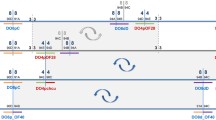Abstract
We found a rare inversion which is superimposed on the In (2R) NS chromosome. It has been maintained for several years in the Raleigh, N. C., USA population and possibly for more than ten years in the southern populations of the USA. Both the breakpoint of the rare inversion and the corresponding site of the In (2R) NS chromosome have P elements and therefore, the rare inversion might be induced by P element activity in a natural population.
Similar content being viewed by others
References
Ashburner, M. & Lemeunier, F., 1976. Relationships within the melanogaster species subgroup of the genus Drosophila (Sophophora) I. Inversion polymorphisms in Drosophila melanogaster and Drosophila simulans. Proc. R. Soc. Lond. B. 193: 137–157.
Bridges, C. B., 1935. Salivary chromosome maps. J. Hered. 26: 60–64.
Engels, W. R., 1984. Formation of chromosome rearrangements by P factors in Drosophila. Genetics 107: 657–678.
Engels, W. R., 1989. P elements in Drosophila. In ‘Mobile DNA’ ed. by B uperg, D. E. and H upowe, M. M.
Ish-Horovicz, D., 1982. Transposable elements, hybrid incompatibility and speciation. Nature 299: 676–677.
Lefevre, G., Jr., 1976. A photographic representation and interpretation of the polytene chromosomes of Drosophila melanogaster salivary glands. In: The Genetics and Biology of Drosophila, Vol. la. ed. by Ashburner, M. & Novitski, E.
Langer-Safer, P. R., Levene, M. & Ward, D. C., 1982. Immunological method for mapping genes on Drosophila polytene chromosomes. Proc. Natl. Acad. Sci. USA 79: 4381–4385.
Lindsley, D. L. & Grell, E. H., 1968. Genetic variation of Drosophila melanogaster. Carnegie Institute of Washington Publication 627.
Mukai, T. & Yamaguchi, O., 1974. The genetic structure of natural populations of Drosophila melanogaster. XI. Genetic variability in a local population. Genetics 76: 339–366.
Mukai, T. & Voelker, R. A., 1977. The genetic structure of natural populations of Drosophila melanogaster. XIII. Further studies on linkage disequilibrium. Genetics 86: 175–185.
Nevers, P. & Saedler, H., 1977. Transposable genetic elements as agents of gene instability and chromsomal rearrangements. Nature 268: 109–115.
Rigby, P. W. J., Dieckmann, M., Rhodes, C. & Berg, P., 1977. Labelling deoxyribonucleic acids to high specific activity in vitro by nick translation with DNA polymerase I. J. Mol. Biol. 113: 237–251.
Rose, M. R. & Doolittle, W. F., 1983. Molecular biological mechanisms of speciation. Science 220: 157–162.
Stalker, H. D., 1976. Chromosome studies in wild populations of D. melanogaster. Genetics 82: 323–347.
Sved, J. A., 1979. The ‘Hybrid Dysgenesis’ syndrome in Drosophila melanogaster. BioScience 29: 659–664.
Thompson, J. N. & Woodruff, R. C., 1978. Mutator genes-pacemakers of evolution. Nature 274: 317–321.
Author information
Authors and Affiliations
Rights and permissions
About this article
Cite this article
Kusakabe, S., Harada, K. & Mukai, T. The rare inversion with a P element at the breakpoint maintained in a natural population of Drosophila melanogaster . Genetica 82, 111–115 (1990). https://doi.org/10.1007/BF00124640
Received:
Accepted:
Issue Date:
DOI: https://doi.org/10.1007/BF00124640




